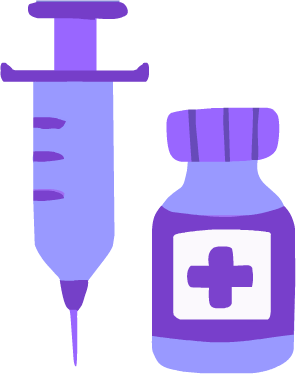Virus, vaccine,
viral subject.
Educational invitations from Charles Sol, educational director of eduMedia and Jean-Daniel Doucet, M.Sc., scientific popularizer.
April 2021.
How does a virus infect us?
Before it can infect a single cell in our body, a virus must enter our body by crossing the body’s first line of defense: the skin. Entry can be by air (breathing), by ingestion, or by contact with bodily fluids. Thus, the importance of “barrier gestures” such as: washing hands, avoiding touching your face, wearing a mask or condom, coughing into one's elbow, and social distancing.
If our body is confronted with a new strain of virus, it is possible that our immune system will not be able to react in time to develop an adequate response. Unhindered, the virus can then replicate in our cells. At the beginning of an infection, the viral load (number of virus copies per milliliter) is not detectable by laboratory tests. The patient is then asymptomatic, but potentially contagious. It is only after a while that the disease is manifested.
For more details on virus replication, here is an example of the replication cycle of HIV that causes AIDS.
What is the difference between an epidemic and a pandemic?
When the virus spreads within a population in the same place, it is called an epidemic. If the virus crosses borders and continents, we are talking about a pandemic. Even in the presence of a vaccine, “barrier gestures” such as physical distance, masking (for airborne pathogens) and hand washing remain important in stemming the spread of a virus. The simulation on the other side illustrates the dynamics of an epidemic.
What is an immune response?
Our immune system defends us against foreign bodies. It distinguishes the “self” from the “not self”, that is, it differentiates between our own cells and the invader cells. The mechanisms of immunity are complex and numerous. Below we illustrate the broad, widely simplified steps of so-called acquired immunity. It is precisely this main immune response which is stimulated by vaccination.
Any cell or virus is identified by proteins on its surface. These proteins contain antigens that identify pathogens.
Sentinel cells in our immune system scan for these antigens. They can activate defense mechanisms in the event of an intrusion.
In the event of an alert, specific antibodies are generated in large numbers by B lymphocytes.
Antibodies attach to the antigens on the pathogen's surface.
The pathogen is neutralized by antibodies and other immune cells.
Antibody
This animation shows in more detail the immune response that leads to the destruction of a pathogenic bacterium. Note the differentiation of lymphocytes into antibody-secreting cells and memory cells. To be immune to a disease means having such memory cells.
How do vaccines work?
There are many types of vaccine. They are all based on the same principle: stimulate our immune system to prepare it for a pathogen before it infects us.
Injecting an inactive portion of the virus stimulates sentinel cells and then B-cells to produce large numbers of pathogen-specific antibodies. The organism is thus prepared in case of infection, as indicated by the simulation.
How are vaccines made?
Pharmaceutical companies must ensure that their vaccine candidate is safe and effective for humans. They work with medical institutions, doctors and volunteer patients. The entire procedure must be approved by an ethics committee.
For each phase of a clinical trial, the results are compared between one group that received the vaccine and another group that received a placebo. The risks and benefits of the vaccine candidate are then assessed. Developing a vaccine normally takes several years. The bulk of the time is usually spent on administrative issues, not on clinical trials as such. The animation above illustrates the classic three-phase protocol with placebo group.
Glossary
Immunity: An organism's ability to defend itself against pathogens.
Innate immunity: A type of immunity that is not specific to a single pathogen. The skin serves as the first barrier. Some sentinel immune cells, such as neutrophils or macrophages, are part of innate immunity and react quickly to invaders.
Acquired immunity: A type of immunity that specifically recognizes pathogens. It requires a “training” of lymphocytes. This is the type of response that is triggered with vaccination.
Antibodies: Antibodies neutralize pathogens by sticking to their antigens.
Antigen: These are proteins found on the surface of pathogens. They act like little flags that announce to our bodies, “I am an intruder.” These signals allow our immune system to recognize invaders and produce antibodies to fight them. In English, the word “Antigen” is the acronym for “Antibody Generator.”

“The best doctor is nature: she cures three quarters of illnesses and never speaks ill of her colleagues.”